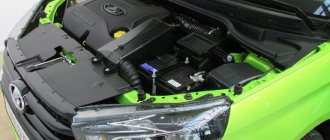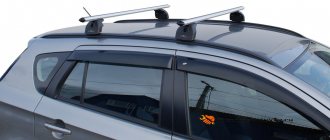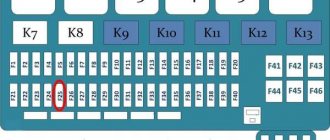AvtoVAZ has not had such a model as the Lada Vesta for a long time, one might say never. The car is a technological breakthrough for VAZ. Vesta meets the requirements for modern cars. The car has a stylish and recognizable design. For any car, many parameters are important: engine, trunk size, wheel size, but the interior—where the driver is constantly located when driving the car—remains an important factor when choosing. Vesta is a beautiful car on the outside, but let's look inside and see what's there. Lada Vesta is made using new plastic materials. For the first time in a VAZ car there are several interior variations!
- Sedan interior
- Photo of the interior of the sedan modification
- Dimensions of the Lada Vesta interior and comparison with competitors
- Salon Lada Vesta SV cross
- Vesta Cross interior colors
- Salon Vesta SV
- Salon Vesta Sport
- Interior of Lada Signatur (Long)
Photo of the interior of the sedan modification
Inside the Lada Vesta car, materials and innovations were used that had not been used on a vase before. This made overall operation more pleasant for people; for the first time on a vase, the steering column could be adjusted for reach and installation angle. The steering wheel can be adjusted for reach by 50 mm and angle by 7 degrees. Vesta now has a multifunction steering wheel, which was not previously available on any VAZ model. The steering wheel has a three-spoke badge in the middle, it looks made with high quality and accuracy! The steering wheel has control buttons for the cruise control radio and telephone.
The instrument panel is interestingly implemented; it is grouped into three wells, all of which resembles a sports car. The quality of the panel material is good. The panel has few lamps, but despite this it looks informative. The torpedo is made of dark plastic. The center console is level with the panel, but protrudes forward a little and this is convenient for use; you don’t need to reach out to press a certain button. The console is divided into two parts, but depending on the configuration, it is located on top (in the expensive configuration there is a multimedia system with a 7-inch screen), and a branded radio in the cheaper basic version. On the second part of the panel there is a climate system separated by a row of buttons. The central tunnel is equipped with two cup holders.
The car has good visibility; the arches do not interfere with the view, as on the previous model 2170. Two airbags are built into the front panel (driver plus passenger). Regarding the interior trim, it looks high quality. The door cards, by the way, use new Soft Look plastic, are visually similar to leather. The plastic is embossed and hard to the touch. Despite the cheap materials, the interior looks quite strict and not childish, and if the car is in the Luxury configuration, the interior is equipped with additional chrome inserts. In general, Vesta’s interior looks a class higher than it is: ergonomic seats with good upholstery, all instruments and elements are arranged thoughtfully. When you get into the car, it’s pleasant to be in, you can see the road, and it’s easy to read the information on the speedometer. The seats have a high depth of adjustment, which allows tall people to feel comfortable behind the wheel. In previous models, there was limited space in the back, which was a big minus. There is ample knee room behind the driver; the distance from the rear sofa to the front seats is 226 mm. In general, it feels like the dimensions inside the car have been thought out. The seats are comfortable, the headrest follows the lines of the body and is friendly with the back of the head when standing in a traffic jam. The distance from the floor to the rear sofa is 345 mm, and from the floor to the top of the front seats is in the range from 276 to 310 mm. The distance from the floor to the steering wheel (since it is adjustable) is from 450 - 528 mm.
Ease of configuration
However, the aesthetic appeal of the Lada Vesta’s interior is only half the success. The second half is the convenience of a beautiful interior, expressed in a lot of details.
The front seats, starting with the “Comfort” configuration, receive adjustable heating, and a productive and powerful air conditioner is built into the design itself. Passengers will not freeze in the car in winter and will not need open windows in summer.
The front seats are adjustable in angle from the basic version of the Lada Vesta. The driver's steering wheel in the same basic configuration can already be adjusted by rollout. Unfortunately, the ability to adjust both the seats and the steering wheel in terms of tilt, height, and rollout appears only when purchasing Vesta in the “Lux” assembly - however, the level of convenience allows this model to stand out among many others presented in the segment.
The manufacturer paid attention to safety. Starting with the Classic trim, the driver and all four passengers each receive a seat belt—which includes visible indicators if the passenger or driver is driving unbelted. The basic assembly includes a driver airbag and, optionally, a front passenger airbag. In subsequent trim levels, airbags for rear passengers also appear, and later - side airbags, which fix passengers and the driver in their places and prevent lateral sliding with subsequent impact.
Thanks to its customization capabilities, the car is comfortable even for fairly tall drivers and passengers (above 190 cm). Very few models presented in class B can boast of this. The Lada Vesta passed all the necessary crash tests, and the safety level of its interior was recognized as close to ideal (of course, for the maximum configuration).
More details about Lada “Vesta” cars
Dimensions of the Lada Vesta interior and comparison with competitors
As a basis for comparison, let's take the interior of the closest 4 competitors of our Vesta. The distance from the front seat (when the driver is sitting in it) to the ceiling is 1020 mm. If we take the competitors, then only Logan wins, it has 1030 mm, Solaris has 1015, Ravon Gentra 1015, Polo has a modest 1010 mm. The distance from the pedals to the knee and to the back of the front seat, depending on the height of the person, is in the range: 975-1175; Logan has a distance from 960 mm to 1190; Hyundai Solaris has from 970 to 1190; Ravon has numbers from 965-1145; Polo 955-1150. Interior height in the middle of the car: Lada Vesta – 1190 mm; Logan - 1210 mm; Solaris – 1200 mm; Ravon – 1170 mm; Polo – 1180 mm. The distance from the rear sofa (with a passenger) to the ceiling is 2180-925 mm; by the way, the Solaris is the same. Ravon has 960 mm, just like Logan; Polo-935 mm Distance from the back of the rear row to the front seat: Vesta from 610 to 850 mm; Logan from 645 to 855 mm; Solaris from 565 to 810 mm; Ravon from 660 to 890 mm; Polo from 632-880 mm. It is clear from the numbers that our car is not the tightest.
Interior trim and ergonomics
The soft surfaces of the Lada Vesta interior are finished with fabric and leather, as well as soft-look plastic, which visually resembles soft leather, but is sufficiently hard to the touch. The surface of the plastic is embossed, giving the interior a strict appearance. The quality of finishing materials is quite consistent with the price class to which the Lada Vesta belongs.
To decorate the interior of the luxury package, chrome inserts are used.
Improving the aesthetic parameters of the seats is achieved by using gray inserts in their upholstery, photo below:
From an ergonomic point of view, the interior of the Lada Vesta is designed like a car of an older class. The controls and monitoring instruments are located very well, and the indicator readings are read quickly and accurately.
Salon Lada Vesta SV cross
Since the cross body car came out at the end of '17, its interior is no different from the '18 car. Both the driver and the passenger feel comfortable sitting in the Cross. Many people are interested in the question of whether the Lada Vesta has 7 seats, the answer is: it doesn’t, there are no 7 seats in the interior of the crossover, there are only 5 of them.
Let's start with the Cross steering column; outwardly it is no different from the steering wheel of a Vesta sedan - all the same buttons for controlling the multimedia system. However, there are differences: in any configuration of the Vesta Cross, the steering wheel is covered with leather.
Photo of the interior of the cross modification
The central panel is no different from the sedan, everything is still harmoniously located in its place, which makes driving easier. There is a glove box mounted on the panel on the right; it has a decent volume. In the center of the cabin there is a central tunnel with cup holders and a gear knob. The handle of the box depends on what kind of box is on the car.
After the gearbox there is an armrest, convenient for the elbow of the right hand. The plastic in the cabin is the same everywhere, in the door cards and on the dashboard. Door cards have harmonious inserts that highlight the design. The doors have spacious containers in which you can put small things or a bottle of drink. Overall the door finish looks decent. Each door has its own electric lift, and the driver's window control unit with rear door locking and mirror adjustment.
The Vesta Cross floor is carpeted everywhere. It can be called a classic flooring material in many foreign cars and vases. The ceiling on Vesta Cross is light, but it is made with high quality; in case of contamination, the dirt can be easily washed off.
Report from the start of production of Lada Vesta (+ photos of the exterior and interior of production versions)
The revolution has happened. There are no more “foreign cars”.
What has been talked about for so long on the RuNet has come true. Production of a new AvtoVAZ model, the Lada Vesta, has started. I have long been irritated by the word “foreign car”, I considered it an anachronism, a relic of the eighties, when boxy Zhigulis reigned on the roads, diluted with awkward Muscovites and either killed to death, or luxurious Volgas inaccessible to mere mortals, and other cars were just appearing, the design of which amazed the imagination of inexperienced people. Time has passed, Zhiguli cars are long gone, but the stereotype remains.
Now, having visited the production of the Lada Vesta in Izhevsk, I would exclude the word “foreign car” from use. Now all cars of the same class are the same, regardless of the place of their production, and I think that Vesta will finally be able to break the stereotype of the average person’s attitude towards VAZ products.
The theater begins with a hanger, and the production of a car begins with the body. Before the ceremony, we were given a tour of Vesta's body production. They showed everything from stamping body parts from sheet metal to welding these parts into a body ready for painting and assembly. What to say? Overall the impression is very favorable. Light, clean, looking at the shiny floor, you can shave. All workers undergo training upon entering work, each workplace is personalized. You cannot let a marriage go and remain unpunished. However, according to Valery Grigorovich, head of the geometry department, only 20% of the quality here depends on the human factor. The rest is equipment operation. And here it is the most modern, most automated. At the same time, quality control of body welding occurs constantly. One body per week is subjected to tensile testing, and geometry is checked every two hours, four times per shift.
The theater begins with a hanger, and the production of a car begins with the body. And this is a factory?! Looking at the floor, you can shave...
Equipment for stamping body parts. The weight of some stamps is up to forty tons
The level of compliance of welding points with those specified during design can correspond to 80%. But, according to V. Grigorovich, this level will only allow reaching the level at which the car can be somehow assembled and it will drive. But how its doors will close, what body clearances there will be - that’s another question. Therefore, the level of compliance here has been brought to 95-97%, thanks to which we have obtained a completely different level of car quality. Looking ahead, I will say that both the gaps and the sound of the door closing are impressive. “Like a foreign car,” many would say. Let me remind you that I try to avoid this word.
3D quality control of body parts manufacturing.
Each worker has his own rating based on the quality of his work
Body parts welding shop. Everything is automated as much as possible, the influence of the human factor is minimized. Pay attention to cleanliness and order
Up to 120 units are manufactured using 19 pieces of equipment. Changing equipment to move on to the production of another unit is carried out in no more than 5 minutes. Women work where great physical strength is not required
3D body control section
Robot turning bodies. In local slang - "Godzilla"
But they didn’t let us into the painting shop, arguing that outsiders had nothing to do in pure production. Well, since they didn’t even make an exception for us on such a day, it means that everything is really serious. No one needs a defective paint job, and a visit to the workshop by a group of journalists cannot be an excuse. Among other things, it was said that seven new colors were specially developed specifically for Vesta, such as Lime, Krypton, Blues - all these are metallics.
The head of the painting shop showed us the work of his shop on the big screen. But he didn’t let me into the workshop
Some would call it a “straightening man’s nightmare”...
Well, then - the most annoying part, but that doesn’t make it any less important. Assembly. And even here, where, it would seem, nothing new can be invented, certain innovations have been introduced. So, for example, doors are now subassembled before installing them on the car, which allows, firstly, to carry out this assembly more carefully and efficiently, and, secondly, eliminates the possibility of damage to the paintwork.
The so-called “technological cribs” are suspensions on which doors are assembled
All jobs are personalized. Such a stand with a photograph and the name of the employee is available at each workstation, as they say here.
Everyone can make suggestions to improve the work process
I see no point in retelling the words that were spoken during the ceremony. Of course, these were words of gratitude to the workforce, as well as to the leaders of the state and regions, the Samara region and Udmurtia. I was impressed by the words of Bo Andersson, General Director of AvtoVAZ, and I cannot help but mention them:
"We did it! We did it on time, and we did it well!” - these were the words of a man who, not without reason, was proud of his work and the work of the team entrusted to him.
The hero of the occasion before the celebration begins. The color is called "Pluto"
Solemn moment
Bo Andersson, General Director of AvtoVAZ, Mikhail Babich, Plenipotentiary Representative of the President in the Volga Federal District, Alexander Solovyov, Head of Udmurtia
Soloviev, Babich and Andersson signed the hood of the first Vesta as a souvenir
Bu Inge also spoke about an interesting experiment that he conducted on the streets of Frankfurt. The video is already on the Internet, where you can see how Vesta without identification marks is presented to passers-by on the street, who were asked two questions: “What kind of brand do you think this is?” and “How much would you be willing to buy such a car for?” In response, brands such as Kia, Hyundai, Ford were named... But as for the price that sophisticated burghers would be willing to pay, many were willing to part with amounts in the region of 20-25 thousand euros. Impressive, isn't it? After showing this video, Andersson stated that he intended to return the Moscow and St. Petersburg markets to AVTOVAZ, and after them enter the European market. Boldly. Self-confident. But... we all see the results of his work, and the facts speak for themselves. Vesta - one year from concept to start of mass production. What is not an example of the potential of an enterprise?! By the way, at the end of his speech, the head of AVTOVAZ said that exactly a year later, production of the Lada Vesta Cross will begin here, at the Izhevsk site. With all that said, I can't help but believe it.
According to Oleg Larin, head of the assembly workshop, only 20 Vests are currently assembled per day. But the pace will increase, and already in 2016 it is planned to produce about 70 thousand cars of this model.
Now about the main thing. Price. At the moment, the price of Vesta, according to Andersson, ranges from 495 to 600 thousand rubles. Yes, I know that with the current unpredictable exchange rate of the ruble, thinking ahead is a thankless task. However, Vesta’s localization level is 71%, which is quite a lot, and this is the part on which the impact of currency fluctuations is minimal.
Trunk volume is always interesting
Optics with the inscription "Lada"
Everyone wants to drive the first Vesta
The ceremony was attended by Oleg Grunenkov, director of the XRAY project (“X Ray”), who is also responsible for conducting presentations of new models. He spoke about the level of localization in more detail. Components such as ABS units and airbags come from abroad. The bodies, as we already know, are made here in Izhevsk from Magnitogorsk metal. Motors, chassis and transmission elements come from Tolyatti, from the main plant. But, as I found out a little later, not everything is so simple here either. At the moment, Vesta is equipped with two engines and two types of transmissions. There is a VAZ sixteen-valve engine with a volume of 1.6 liters and there is a Renault engine of the same volume, there is also a manual transmission and there is an AMT, simply a “robot”. But already at the moment, by the start of mass production of this car, the assembly of Renov engines from components coming from France has been mastered in Togliatti. The situation is the same with the Renova manual transmission. It is also assembled at AVTOVAZ from French components. But the “robot” is ours, dear, from VAZ, already familiar to us from Priora and Granta.
Well, for dessert, journalists were given an impromptu test drive around the plant. Of course, I understand that a new car is a new car, and you can’t judge the model as a whole by driving the car for about one kilometer at a speed of no more than 60 km/h, but I’m still impressed. I wouldn’t dare call this car the word “Zhiguli”. The doors open without a hint of “biting”, known from Granta and Kalina, they close softly and with a pleasant dull sound, the seat is adjustable in height, the steering wheel is adjustable in both tilt and reach, good sound insulation... And this is all in the basic configuration. I will deliberately not talk about the driving properties of the car for now, because that short demo drive is clearly not enough to evaluate them. It steers well, minor bumps go through without breakdown of the suspension and without discomfort for the driver and passengers. That's all for now.
By the way, regarding the configurations. How do they differ from each other? The luxury version will, of course, have air conditioning, airbags not only front but also side, full power accessories, touch screen controls for the multimedia system and navigation. In the “Norma” configuration, which I was able to ride, there is no touch screen, and there is no navigation. The rear windows are “on the oars”, but the external mirrors are heated and electrically adjustable. There is also ESP. And in the minimum configuration there is no longer an air conditioner, just as there is no electric mirror drive. EUR is available in all trim levels. “Crickets”... are not yet available in all trim levels. Well, the design... you can't please all tastes. Some will call it controversial, some will unconditionally like it, and others will call it “a straightener’s nightmare.” I like it.
In general, as I said at the very beginning, it’s time to forget the word “foreign car,” as well as the word “Lada,” which has recently been used in a derogatory sense. There is a word "car". Where it was released no longer matters. Like this. The revolution has happened. Skeptics can, of course, argue with me, but I believe the facts and I believe my eyes.
Lada Vesta - exterior photos, production version of the model
Lime color Vesta. It looks different from different angles, ranging from bright green to yellow with a slight green tint. Color for those who are not afraid to stand out from the crowd
Lada Vesta - interior photos, average level of equipment (“Norma”)
The rear one is switched on “to the right and back”. Simple and logical. There is no need to press down, there are no additional locks
My height is 178 cm. I don’t rest my knees “behind me”, but there is very little space left in front of them
There are only a couple of centimeters left above your head
“Robot” is known to us from Priora
Keys to Lada. I've already seen this somewhere...
Lada Vesta - photos of the interior of the top-end configuration (Luxury)
The “Lux” package is equipped with a touchscreen
Goodbye door lock buttons
Steve Mattin happily poses for journalists on the day of his triumph
Salon Vesta SV
It is distinguished by poorer colors, for example, the SW station wagon does not have orange. Otherwise, the interior of the station wagon is similar to the cross.
Photo of SV salon
Lada Vesta review - engine, chassis and gearbox
The 1.6 liter engine has a power of 123 hp. s., which is at the level of cars of this class. The dynamics suffer a little against the background of the robotic gearbox. The handling is soft, the car clearly responds to steering turns. Experts call Vesta's steering one of the best in its class.
The chassis assembly allows you to fully enjoy steering even on the worst roads.
Serial photos of Lada Vesta from the plant in Izhevsk
We have already reported more than once about receiving photographs from the plant in Izhevsk. So, in order, what we have.
Workers managed to capture one of the first assembled versions, which stood in the workshop in Izhevsk to be shown to managers
Back view. Someone even sits inside the cabin and looks at the new product
After a while, the management of AvtoVAZ and IzhAvto decided that it was time to “warm up” the audience a little and posted an official photo.
But recently we managed to get pictures of the Lada Vesta painted in new colors.
Photo of a car in Mystery color
“Lux” package. Lemon color. A very bright and unusual color for Lada. We think that young girls (and some guys) are the target audience for this color
Also an interesting “youth” color called “Amethyst”
photo of a manual transmission knob
This is what the handbrake of the future new product looks like
Photos of Lada Vesta
Exterior photo of Lada Vesta - appearance
From the outside, a sharp transition from the old school of design to the new one, led by Steve Mattin, is immediately visible. He managed to turn the familiar and discreet VAZ into a stylish and extravagant car that makes people turn around on the street.
Photos of Vesta front part
Naturally, the full face of the model deserves special attention. The massive black radiator grille with a pair of horizontal bars, in the middle of which sparkles the company’s nameplate, immediately catches your eye. And immediately below it, as if continuing the composition, is the central part of the front bumper, made in a similar style and playing the role of an air intake. Interestingly, this black section narrows in the middle and widens on the sides, creating the silhouette of the letter "X". It was not for nothing that it was said that Lada Vesta adopted the basic ideas of the LADA X Ray concept.











